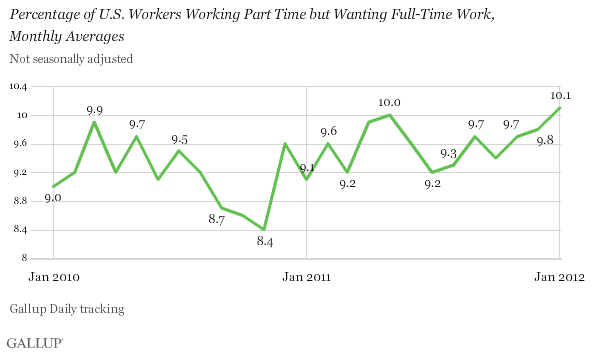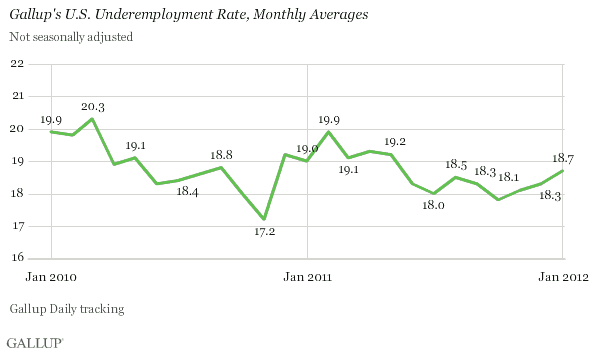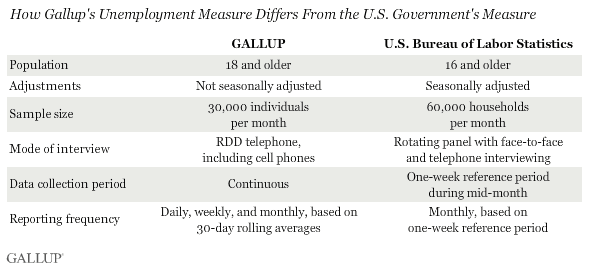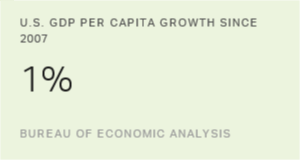PRINCETON, NJ -- U.S. unemployment, as measured by Gallup without seasonal adjustment, increased slightly to 8.6% in January from 8.5% in December, but was down from 9.9% in January a year ago.

The percentage of U.S. employees who are working part time but want full-time work increased sharply to 10.1% in January, from 9.8% in December. The January reading is also substantially higher than the 9.1% of January 2011 and is the highest percentage for this segment of the workforce since Gallup began monitoring it in January 2010.

Underemployment, a measure that combines the percentage of workers who are unemployed with the percentage working part time but wanting full-time work, surged to 18.7% in January. This is a worsening from the 18.3% of December but is still below the 19.0% of a year ago.

Looking Ahead to the Government's Unemployment Report
The U.S. government's January unemployment rate that it will report Friday morning will be based largely on mid-month conditions. At mid-month, Gallup reported that its unemployment rate had declined to 8.3%, based on data collected through the 15th of the month.
The mid-month reading normally provides a pretty good estimate of the government's unadjusted unemployment rate for the month. However, the government is revising its methodology beginning with the January 2012 report. As a result, the government notes, "household survey data for January 2012 will not be directly comparable with that for December 2011 or earlier periods." In turn, this makes estimating the government's unemployment rate for January even more difficult than usual.
Regardless of what the government reports, Gallup's unemployment and underemployment measures show deterioration since mid-January. While the unemployment rate of 8.6% for January is up only modestly from December, this overall increase subsumes the more negative trend of the most recent weeks. In turn, this also seems consistent with Wednesday's ADP report showing less job growth in January than in the prior month.
On the other hand, Gallup's Job Creation Index continues to improve, reaching its highest monthly point since September 2008. Given this context, the increase in unemployment as measured by Gallup may at least partly reflect growth in the workforce, as more Americans who had given up looking for work become slightly more optimistic and start looking for work again. Gallup's data show the workforce participation rate up slightly in January. Taken together, it is important to note that, just as a drop in unemployment doesn't always reflect more hiring, an increase in unemployment doesn't always reflect less hiring. That is, even as hiring improves, the unemployment rate can go up if the number of people looking for work goes up more rapidly, which may be the case at the moment.
Editor's note: Beginning in January 2012, Gallup is reporting full-month unemployment and underemployment results instead of 30-day rolling averages as in the past. Mid-month estimates will continue to be reported on the basis of a 30-day rolling average. No changes or adjustments have been made to the Gallup unemployment and underemployment data themselves.

Gallup.com reports results from these indexes in daily, weekly, and monthly averages and in Gallup.com stories. Complete trend data are always available to view and export in the following charts:
Daily: Employment, Economic Confidence and Job Creation, Consumer Spending
Weekly: Employment, Economic Confidence, Job Creation, Consumer Spending
Read more about Gallup's economic measures.
View our economic release schedule.
Survey Methods
Gallup classifies American workers as underemployed if they are either unemployed or working part time but wanting full-time work. The findings reflect more than 18,000 phone interviews with U.S. adults aged 18 and older in the workforce, collected over a 30-day period. Gallup's results are not seasonally adjusted and are ahead of government reports by approximately two weeks.
Results are based on telephone interviews conducted as part of Gallup Daily tracking from Jan. 1-31, 2012, with a random sample of 18,645 adults, aged 18 and older, living in all 50 U.S. states and the District of Columbia, selected using random-digit-dial sampling.
For results based on the total sample of national adults, one can say with 95% confidence that the maximum margin of sampling error is ±1 percentage point.
Interviews are conducted with respondents on landline telephones and cellular phones, with interviews conducted in Spanish for respondents who are primarily Spanish-speaking. Each sample includes a minimum quota of 400 cell phone respondents and 600 landline respondents per 1,000 national adults, with additional minimum quotas among landline respondents by region. Landline telephone numbers are chosen at random among listed telephone numbers. Cell phone numbers are selected using random-digit-dial methods. Landline respondents are chosen at random within each household on the basis of which member had the most recent birthday.
Samples are weighted by gender, age, race, Hispanic ethnicity, education, region, adults in the household, and phone status (cell phone only/landline only/both, cell phone mostly, and having an unlisted landline number). Demographic weighting targets are based on the March 2011 Current Population Survey figures for the aged 18 and older non-institutionalized population living in U.S. telephone households. All reported margins of sampling error include the computed design effects for weighting and sample design.
In addition to sampling error, question wording and practical difficulties in conducting surveys can introduce error or bias into the findings of public opinion polls.
For more details on Gallup's polling methodology, visit www.gallup.com.
